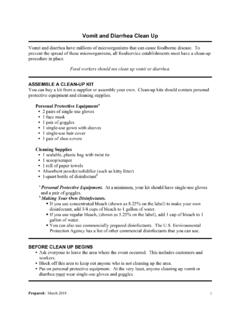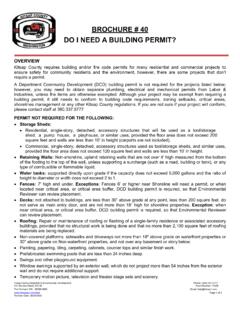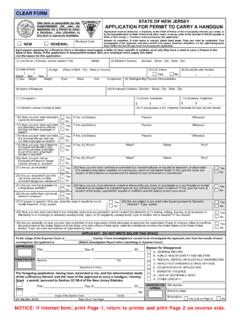Transcription of When do you need a permit for residential work? What you ...
1 when do you need a permit for residential work? What you need to know before beginning a project. Before you start a home renovation project, whether it s a new kitchen, an updated family room or a new sunroom, check to see if you need a building permit . Generally, a building permit is required for ANY construction, installation, repair, replacement or alteration costing more than $15,000. A permit is also required, no matter what the cost, if the work involves the addition, repair or replacement of load bearing members or structures, the addition of plumbing, heating, air conditioning, electrical wiring, devices, appliances or equipment.
2 Examples of work requiring a permit : Decks, carports and garages of any size. Backyard storage buildings exceeding 12 feet in any dimension. Room additions, finishing an unfinished attic space. Relocating or installing new light fixtures that add to the electrical system. Replacing and reconnecting furnaces, etc. Adding to or modifying the heating and air conditioning system. Adding an additional sink or water closet or modifying the plumbing system. Replacing a water heater of another type. Backflow device on landscape irrigation systems. Kitchen cabinet replacement that changes the configuration or exceeds $15,000.
3 Structural repair floor joists, Sub-floor, roof sheathing, headers, piers, footings. when the conditions require a permit for re- roofing projects and mechanical vents associated with gas appliances are penetrating the roof, then a mechanical permit is required as well. * What can be done without a permit ? The repair of non-load bearing components and non-structural repairs. Replacement of windows and doors if they remain in the same location and are the same size. Repairing pickets, railings, stair treads and decking on exterior decks, porches and balconies. Any plumbing equipment or fixture/fitting replacement which does not change equipment size or system capacity.
4 Includes water and drain lines replacement of same size. Like-for-like water heater replacement as long as it remains in the same location (to be done by a licensed contractor only). Vinyl siding replacement, as long as the total cost doesn t exceed $15,000. * Roofing replacement that does not exceed $15,000, uses the same type of materials and no structural work is performed. Repair/replacement of dishwashers, disposals, water heaters, electrical devices or light fixtures provided that the work does not include the addition or relocation of wiring (to be done by a licensed contractor only).
5 *Local ordinances may require review by local government for exterior work. Please contact your local zoning department for more information. Will my project need plan review? Some projects require plan review before a permit can be issued, including the following: All new residential dwellings require plan review. This includes accessory dwellings. Room additions that add more than 100 square feet to the house or increases the foundation footprint. This could include an attached garage, new sunroom, converting a deck or porch to a sunroom or addition of another story.
6 Interior renovations valued at $175,000 or greater and include structural load-bearing alterations. Use of approved alternate methods or methods outside of residential Code. Retaining walls require plans that are designed by a Licensed Professional Engineer. Plans are to be submitted along with a building permit , zoning permit and site plans for retaining walls supporting more than 48 inches of backfill. Retaining walls supporting less than 48 inches of backfill, but crossing over adjacent property lines, or supporting a building or accessory structure shall also meet these requirements.
7 Two-story detached accessory buildings with a fixed set of stairs to the second level. How do I submit my plans? The residential electronic plan submittal process is designed for one-time or custom-built residential projects that require plan review. Customers may complete an online permit application, to include zoning and erosion control forms. Customers then upload files, to the proper supporting documentation section for review and permitting. plans for review must be electronically submitted. Questions about how to submit your plans? See the Plan Review page on our web site at or you can call 980-314- 2633, option 1, then 2, then 1, then 4.
8 Obtaining the necessary permits will: Ensure that your project is safe and up to code. Save money in the long run by making sure your contractor is licensed by the state of North Carolina, has obtained the proper permits and the work has passed the proper inspections. Remove barriers for approval of loans by many mortgage companies that require code compliance checks before approval. Because more lenders are requesting permits, more work that was previously done without a permit is being discovered. when that happens, owners could be required to expose framing, electrical, mechanical and plumbing systems so the required inspections can be performed and pay retroactive permitting fees.
9 This can be costly and disruptive for owners. What information is required? Applications for a building permit will include the following information about the proposed work: A general overall proposed project description. Location of the project. Signature of the owner or licensed agent. Estimated cost, including labor, materials donations, site work, contractor and design professional fees, but not the cost of the land.
















